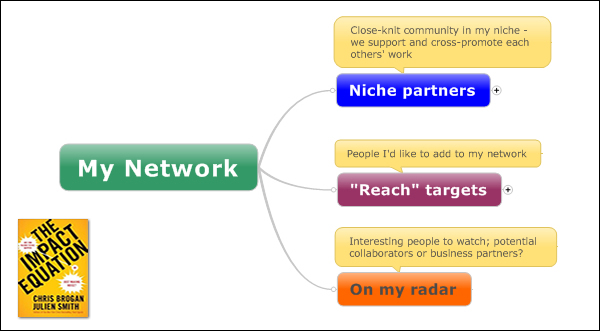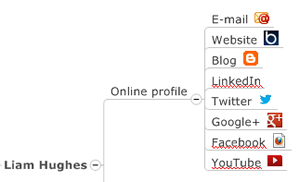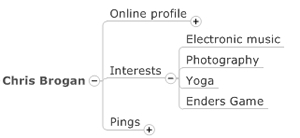
We can only grow our impact and influence through others. That’s one of the core themes of The Impact Equation: Are You Making Things Happen or Just Making Noise?, the excellent new book by Chris Brogan and Julien Smith. But how can you grow your network of contacts and interact with them in meaningful and sustainable ways?
As you grow your network, you collect a wealth of information about each person that gets hard to organize, track and take action on in an organized, consistent way. This networking mind map is one possible tool that can help you do a better job of expanding and working your network effectively – sort of like a visual CRM tool that is designed to help you manage the human aspects of growing your influence online.
Why do I need a mind map like this?
If you’re like most people, you have good intentions of nurturing the people in your network, but real life intrudes and this important but not urgent task tends to get pushed to the back burner. As a result, you pick at it haphazardly. When you see something cool that one of your online friends has posted, you give it a retweet or a +1.
But you don’t really approach network building in an organized, consistent way.
This mind map provides you with a simple framework to do so. It helps you do several things with great clarity:
- Create organized groups of the people with whom you collaborate and manage your interactions with them better
- Identify key people with whom you would like to build relationships, and identify “common ground” (shared interests) and ways in which you can add value to what they’re doing
- Make it easy to get a complete picture of what’s going on their world.
- Easily set up tasks and reminders for the things you need to do to build relationships with them and grow your sphere of impact and influence
The nice thing about this mind map format is it’s both a monitoring tool and a platform for taking productive action.
The screen shot above gives you a 50,000 foot overview of this relationship management map. Let’s drill down a bit deeper to help you understand how such a mind map could work for you.
Three main sections
This mind map contains three top-level topics. Here’s what they’re designed to do:
 Niche partners: One major section of your mind map – where you focus the most attention – needs to be the network of people in your industry, profession or topic niche whom you’re already close to. You can gain a lot of value and grow your influence by supporting and promoting each others’ online initiatives. Liam Hughes at BiggerPlate.com (the world’s largest and best mind map gallery) are doing that now, tweeting about each others’ initiatives once or twice a week. Insert your own network name here, and identify the folks in your niche who are part of your “core group” of like-minded info publishers. Then use this section of the map to manage your interactions with them in a more deliberate way.
Niche partners: One major section of your mind map – where you focus the most attention – needs to be the network of people in your industry, profession or topic niche whom you’re already close to. You can gain a lot of value and grow your influence by supporting and promoting each others’ online initiatives. Liam Hughes at BiggerPlate.com (the world’s largest and best mind map gallery) are doing that now, tweeting about each others’ initiatives once or twice a week. Insert your own network name here, and identify the folks in your niche who are part of your “core group” of like-minded info publishers. Then use this section of the map to manage your interactions with them in a more deliberate way.
 “Reach” targets: These are people outside of your niche who have audiences complementary to yours – people who ideally ought to be part of your readership. Or perhaps they are A-list bloggers whose work you admire, and whom have complementary audiences to yours. In any case, you need to identify these people, gather together their online feeds into one location and then look for logical opportunities to promote their work that may be of interest to your readers. You can then set tasks to ensure that these things get done.
“Reach” targets: These are people outside of your niche who have audiences complementary to yours – people who ideally ought to be part of your readership. Or perhaps they are A-list bloggers whose work you admire, and whom have complementary audiences to yours. In any case, you need to identify these people, gather together their online feeds into one location and then look for logical opportunities to promote their work that may be of interest to your readers. You can then set tasks to ensure that these things get done.
 On my radar: These are interesting people who may have mutually exclusive audiences to your efforts, but whose work you admire. You can learn much from the creative promotion and content development techniques they’re using – not to copy them, but to be inspired by them and to adapt the spirit of their successful strategies to your niche and audience.
On my radar: These are interesting people who may have mutually exclusive audiences to your efforts, but whose work you admire. You can learn much from the creative promotion and content development techniques they’re using – not to copy them, but to be inspired by them and to adapt the spirit of their successful strategies to your niche and audience.
Online profiles: A more complete picture
 You’re only seeing a fraction of what your online colleagues are doing online at any given time. Because the number of social channels have exploded in the last several years, it’s getting much harder to get a complete picture of each person’s interests, passions and pasttimes. But this section of the human networking map can help considerably, by gathering links to all of their “stuff” in one place.
You’re only seeing a fraction of what your online colleagues are doing online at any given time. Because the number of social channels have exploded in the last several years, it’s getting much harder to get a complete picture of each person’s interests, passions and pasttimes. But this section of the human networking map can help considerably, by gathering links to all of their “stuff” in one place.
If you decide, for example, that you really ought to see what Liam Hughes has been up to lately, you can simply click on each link in this section of the map, and visit their various points of presence online. If you’d like to communicate with them, the e-mail topic has a “mailto” embedded in it, so you can quickly drop them a line to tell them, “Hey! Great job on your new project!”
Identifying common interests
 This is where you outline what each person is passionate about. You gets hints of that from reading their blog posts and viewing their updates on sites like Facebook and Google+. But this is where you identify shared interests, which you can use as conversation starters. For example, Chris Brogan is really into electronic music, and has even tried his hand at creating some tracks. I’m into modern synthpop music. If I come across a more trancey track I think he may be interested in, that’s an opportunity to reach out and share something that’s potentially of mutual interest.
This is where you outline what each person is passionate about. You gets hints of that from reading their blog posts and viewing their updates on sites like Facebook and Google+. But this is where you identify shared interests, which you can use as conversation starters. For example, Chris Brogan is really into electronic music, and has even tried his hand at creating some tracks. I’m into modern synthpop music. If I come across a more trancey track I think he may be interested in, that’s an opportunity to reach out and share something that’s potentially of mutual interest.
In short, this section of the mind map helps you identify “What’s In It For Them” (WIIFT).
Tasks
As The Impact Equation correctly points out, you can’t simply reach out to influential people online and say, “Hey! I just published a new e-book. Would you mind telling your readers about it?” You need to first need to pay value to them – in ways that are meaningful to them. Ideally, this shouldn’t a quid pro quo. You should share their worthwhile stuff with your readers because it’s the right thing to do – because these nuggets should be of interest to your network – not because you expect something in return. In that way, you build some positive karma so at some future date, you can make an “ask” and have a reasonable chance of getting a slice of their limited attention.

One of the marvelous capabilities of mind mapping software – which few people seem to use – is task management. You can:
- Set up follow-up dates and have the software alert you when a task is due
- Set priority levels, so you know what to focus on first and next
- Filter the entire content of this map to display only the tasks – so you can easily zero in on your to-do list and hide all the other extraneous information
- Attach related documents, links and other relevant information.
- Control the amount of data you’re viewing at any given time by simply expanding and collapsing topics.
The key to a successful task management system is simplicity. This mind map is designed to enable you to add, update and manage tasks quickly.
Download this mind map
Download the Impact Networking Mind Map (MindManager 9 .mmap format)
Download the Impact Networking Mind Map as a PDF file
Most mind mapping programs can import MindManager maps. If you use a program that doesn’t, please contact me and I’ll generate one in a format you CAN use.
Like the thinking here? Then consider joining the Mind Mapping Insiders group
This type of analysis and “how-to” focus is typical of the type of reports that Mind Mapping Insiders get access to, with new resources added several times per month. If you want to increase your impact, becoming a visual thinker is a powerful strategy that can help you on your way to this goal. Click here to learn more!

Leave a Reply